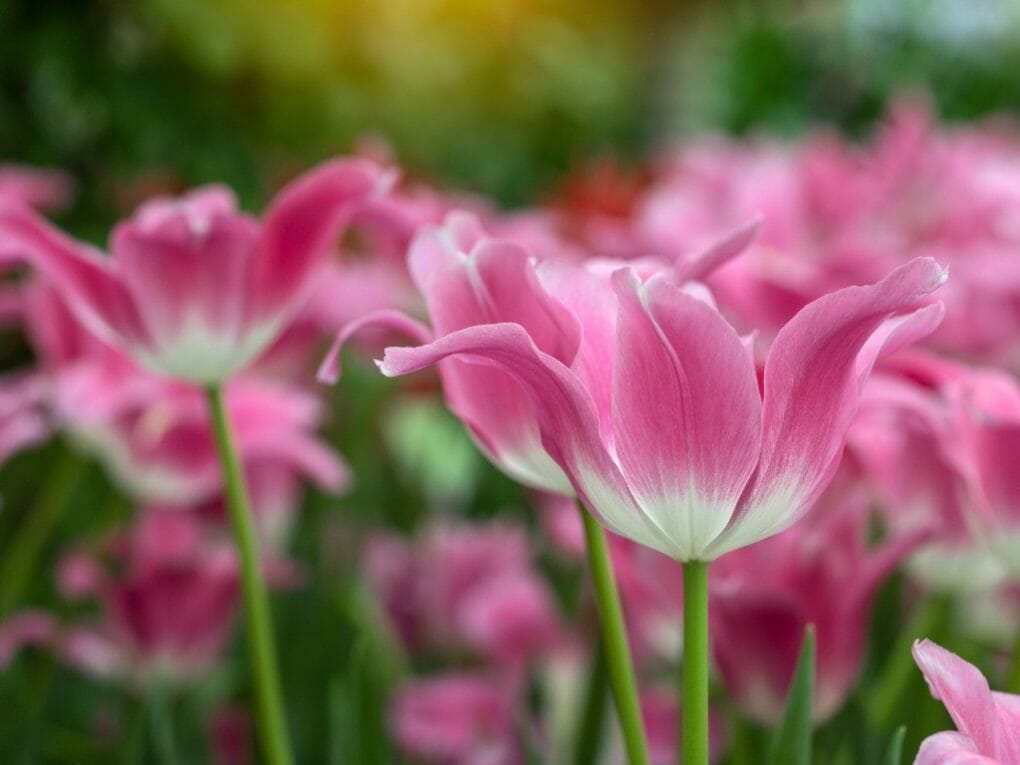Are Tulips Edible? Know The Parts That You Can Eat

Many parts of the tulip, like the petals and bulbs, can be eaten. It would be best if you didn’t eat the stems and leaves. Suppose a tulip bloom has not been treated with pesticides or other potentially dangerous chemical agents. In that case, it is possible to consume many different sections of this delicate and noble flower. It all depends on the size and type of the tulip, but the petals have a lot of crunch or chewiness. In contrast to bitter, old and dried tulip bulbs, fresh tulip bulbs have a milky and sweet flavor and are highly regarded for this flavor profile.
When added to an earthy green salad, the petals of a tulip provide a delicious scent, an enticing texture, and flavor all at the same time. When gathering tulips for consumption, one must exercise extreme caution and ensure that they do not consume tulips that have been treated with chemicals or are found growing along the side of a road.
A bulb from the tulip flower, related to onions, can be prepared and eaten in a way that’s not unlike that of potatoes. In 1944, after the Battle of Arnhem in World War II, the Dutch of Holland suffered from extreme starvation, and eating tulips became more of a necessity than a delight. When picked when young, Tulip blooms can be used as edible cups for serving sweets or savory foods.
Table of Contents
Parts of Tulip That You Can Eat
Both the tulip’s petals and bulb can be used in culinary applications. The tulip’s stem and leaves should not be consumed. When tulips are harvested for culinary use, care must be taken to ensure they have not been exposed to chemicals or pesticides. Tulip bulbs should be peeled off and cut in half, and remove the bitter yellow center as this part is poisonous. It can cause stomach upset for some people, although tulip petals are usually fairly pleasant and tasty when cooked.
Tulip’s Taste
You can eat a tulip’s petals for a sweet lettuce-like flavor, a bean-like flavor, or a peppery flavor and a crunchy or chewy texture. Goat cheese, a vinegarette, or walnuts are just a few foods that combine wonderfully with tulip petals. Camargue, Purple Prince, and Lalibela are three varieties of tulips whose petals are among the most delicious. When tossed with a salad, tulip petals bring color and visual appeal while also cooling the palette with their crisp texture and a wide range of flavors from start to end.
If the tulip bulb is fresh and untreated, it may have a flavor resembling onion, potato, or milk, and it will have a good deal of texture and chew. Some say eating dried, and older tulip bulbs are akin to chewing on bitter sawdust.
Preparing Tulips for Serving
After thoroughly rinsing and pairing with a seasonal salad, fresh herbs, and a vinaigrette dressing, tulip petals are best served at room temperature. Petals cooked can be used to create a sauce or as a garnish for a dish. Consider filling an opened bloom with a savory or sweet filling if you want to offer edible tulips in a visually appealing manner.
Tulip Cuisine
Do not feel alone in your flower-eating curiosity. From ancient China to the Victorian era, there have been resurgences in the habit of feeding on plants and fauna worldwide.
Entrées, desserts, and appetizers made with tulip flowers can be beautiful and delicious. Some examples include mousse and savory nibbles. You should know these specifics before you grab a bunch of tulips and rush over to the kitchen to start cooking.
- It would help if you only bought tulips that have been grown without the use of any pesticides or other chemical treatments.
- There will be a wide range of differences in texture, aroma, and taste amongst tulips of different species and ages.
- Younger tulips may work better than older ones in most cooking applications.
- Tulip bulbs may be poisonous if either raw or cooked.
- Before diving headfirst into a bouquet, test out a small portion and see how your stomach reacts.

Although humans can consume tulip bulbs, doing so may lead to adverse side effects, including, but not limited to, those listed below. Eating tulip bulbs may cause mild gastrointestinal distress, including nausea, vomiting, weakness, shortness of breath, or a general feeling of warmth. Tulips can cause a skin rash if handled too often, but they will disappear if you stop handling them.
Tulip Traditional Dishes
Those who endured severe food shortages in the Netherlands during World War II may find making and eating tulip soup emotionally charged. Because of their high carbohydrate content, tulip bulbs have been substituted for coffee, boiled like potatoes, and used to produce soup. This tulip soup recipe is available for your perusal if you’re interested in cooking up a bowl. In addition to tulip bulbs, the recipe calls for oil, water, onion, and spices.
Perfect Time to Collect Tulip Petals
When the bloom is still closed, the optimum time to collect tulip petals to produce edible shells that may be filled with either savory or sweet ingredients is in the early stage of the bloom. The pistil and stamen must be carefully removed when using the flower for cooking. If you only want to gather the tulip flowers, you should cut the plants where they are attached to the stem. To flourish, tulips require sufficient amounts of sun, good soil rich in nutrients, and sufficient water.
If you want to collect tulip petals and the bulb, you will need to dig up the plant when the bloom is completely colored and slightly open. This will allow you to harvest both the petals and the bulb. If a gardener wants their tulips to bloom the following year again, they should take a hint from the Dutch and harvest only the blooms in April. This will allow the bulbs to remain underground and soak in nutrition. The best time to harvest tulips is either toward the end of summer or the beginning of September.
How to Choose Edible Tulips
Chose Tulips With a Rich Fragrance
A tulip’s aroma will tell you whether or not it’s safe to consume. Earlier-picked tulips have a deeper aroma and often taste like peas. To assist you select tulips for culinary use, each tulip variety has its distinctive flavor and aroma.
Tulips of the Couleur Cardinal variety exude a perfume reminiscent of plums, which is pleasant and enticing. Orange tulips have a distinct sherbet scent and flavor. The City of Vancouver tulip has a mild fragrance and a creamier taste.
Select the Desired Taste by Matching the Hue
It has been suggested that a tulip’s flavor can be deduced from the color of its petals. Taste-wise, red tulips are more commonly sweet. White tulips have an interesting, almost peppery taste. Like broccoli, yellows have a slightly bitter flavor. The flavor of black or deep purple tulips is similar to a faint tang and a crunch.
Pick the Right Feel
Larger petals have a more rigid structure. Tulips, especially the peony and parrot varieties, tend to be chewier.
Think about things like color while deciding on a texture. For use in a salad, larger petals in colors that evoke vegetables, such as yellow tulips, are a good choice.
Avoid Eating If Your Allergic
When introduced to tulips, some people have an adverse reaction. Stop eating tulips immediately if you have an allergic reaction, such as a throat closing or a rash. See a doctor for an assessment if your symptoms persist.
Tulip Recipes
Combine tulip petals with canned fish. Every day of the week, tuna salad might be an excellent option for a nutritious lunch. Remove the petals from the tulip bulbs and use them as an ingredient in your tuna salad. Finally, trim the petals to be approximately a quarter of an inch long. The tulips can be added to the rest of the tuna salad components.
You’re free to experiment with whatever you desire in your tuna salad, but we recommend trying it with tulips and some curry powder or black pepper. Tulips go well with other things, such as cucumber and celery stalks.
Salsa De Tulipes
The salad isn’t complete without tulip petals. Try adding a few tulip petals if you enjoy salads but find them boring. Pick as many tulip petals as you like and toss them in with your salad leaves. Remove a fifth of the base of the tulip petal from its base at the bulb. When preparing a salad, the flavor of the tulips depends on when they are picked. The flavor of tulips plucked in the winter is more refined. Various tulip varieties each have their unique taste. Some tulips, like the oakleaf variety, impart an apple flavor, while others, like the French sorrel kind, leave a tangy citrus aftertaste.
Creamy Iced Tulips
Serve ice cream in tulip flower bowls. The flower head of a tulip can be cut away from the stem and molded into a tasty dessert dish. Ice cream can be served in the flowers by propping up the flower head like a champagne flute. If you want to enjoy tulip blooms, ice cream is not required. The flavor will be enhanced just by having the tulip in your hand.
Appetizer

As a starter, you can make some stuffed tulips. The flower head of a tulip can be stuffed with various ingredients and cooked to make a delightful appetizer. Combine fresh mint or dill, chives, and a pinch of cayenne pepper with two tablespoons (or 30 mL) of lemon juice. Add the seasoning to three ounces of cream cheese and one cup of flaked crab meat. Cut up roughly 25 stalks of asparagus into 5-inch lengths and boil them until soft. About half a cup (120 mL) of your crab mixture should be used to stuff tulip bulbs. The tulips can then be topped with asparagus. Put your tulip bulbs in a pretty arrangement and bring them to the table.
Tulip Meatballs
Use tulips as an ingredient in your next meatball dish. Brown beans, such as pinto beans, and tulip petals, should be cooked and cooled together in a mug. Next, use a spoon or an electric mixer to mash the beans into a smooth paste. Add fried onion, marjoram, and salt to taste the paste and stir well. Tulip meatballs are simply meatballs shaped like tulips. Prepare the balls in a small bit of oil and cook them in a skillet.
Tulip Cocktail
Make a tulip-themed drink. Use tulips to give your cocktail a floral twist. Adding a few tulip petals as a garnish after you’ve mixed your cocktail ingredients is a beautiful touch. This enhances the drink’s flavor and improves its visual appeal.
It’s possible to make a cocktail by combining two ounces of blueberry vodka with one ounce of pink lemonade. After combining the ingredients, serve in glasses over ice. To make the drinks more visually appealing, sprinkle some tulip petals.
